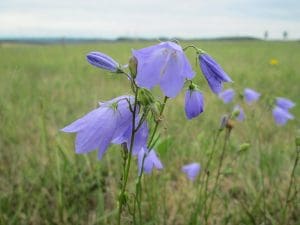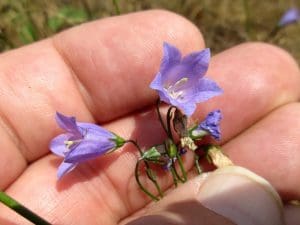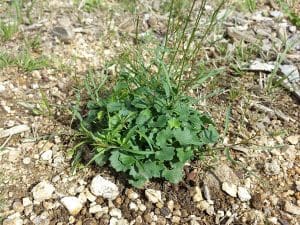Harebell / Spring / Summer / Edible
Harebell produces one of my absolute favourite flowers, I like candying them and popping them on top of cakes I make. Although the leaves are also edible I don’t tend to eat them that often, possibly because I’m so drawn to the flowers I think about nothing else.
Common Names
Harebell, Scottish bluebell, Bluebell of Scotland, Witched Thimble, Fairy Thimbles
Botanical Name
Campanula rotundifolia
Scientific Classification
Kingdom – Plantae
Order – Asterales
Family – Campanulaceae
Physical Characteristics of Harebell
A herbaceous perennial growing from rhizomes with a very delicate bell-shaped blue flower.
Leaves
The basal leaves are a rounded heart shape with a lobed/toothed margin. Further up the leaves become very long and narrow and loose the toothed edge to the leaf.
Flowers
A beautiful delicate violet-blue bell-shaped flower consisting of 5 petals flowering in the summer months. They point slightly downwards from the top of a thin, delicate stemYou may also come across pale pink and white blooms.
Habitat
Very common throughout the UK and temperate regions of the Northern hemisphere. Grasslands, meadows, and sometimes sand dunes. Prefers dry and poor soil.
Known Hazards
None known
Could be Confused with
You may confuse this delicate flower with other Harebells such as the Trawling Bellflower (Campanula poscharskyana) and others in the Campanulaceae family. Luckily none of these are toxic and all are edible.
You also want to be mindful of the common Bluebell (Hyacinthoides non-scripta) which is toxic – especially because their common name is sometimes Bluebell and they both have a blue/purple bell-shaped flower. Bluebells will be found in shaded woodlands, the leaves are long and thin and the blooms are a lot narrower with more clusters on the thicker, juicy flower stem. The Harebell is considerably more delicate.
Edible Uses
The leaves are slightly bitter and can be added to salads or wilted down as a green.
The flowers make a lovely decoration for cakes and desserts or as a garnish.
Notes on Herbal uses
Harebells have been used in traditional medicine for centuries as a diuretic, laxative, and treatment for respiratory and skin conditions.
But there is little research into how effective they are.
Extra notes from the Foragers
The Harebell is shrouded in myth and magic, especially in Scotland with connections to the fairy kingdom and hell. It is believed that witches would have used the flowers in spells and potions to transmute into hares. The Victorian’s believed that fairies slept in the bells.
You can make a blue dye from the flowers which has been traditionally used in Scotland to dye tartan.
Learn a little more on their Scottish Folklore here








